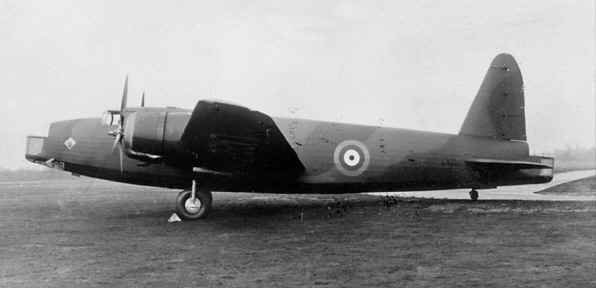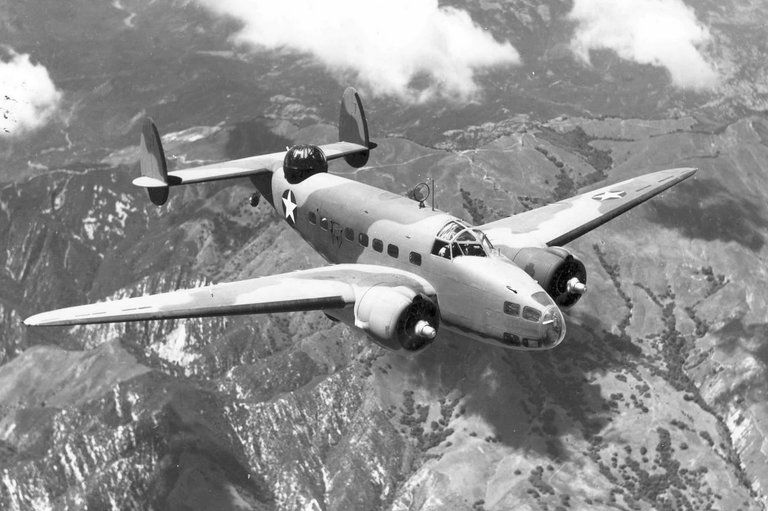For the English Royal Air Force (RAF) the war seriously began on the morning of the 10th May 1940 with the German invasion of the Netherlands and Belgium as well as the onset of the French campaign. Right from the beginning the Advanced Air Strike Force (AASF) and the second bomber group were used to attack lines of communication, bridges and gatherings of troops. Within a week the AASF equipped with obsolete bombers was destroyed. The second bomber command also suffered heavy losses during daylight by the 2,0 cm and 3,7 cm «Flak» and the permanent presence of the «Messerschmitt».
In May 1940 during a crisis of gloominess and despair a new coalition government was formed in England under the leadership of Winston Churchill who occupied both posts as Prime Minister as well as Defence Minister. One of the first acts of this new war cabinet was to order the limitless bombardment east of the river Rhine. As a result of these orders, Switzerland was soon affected visibly and audibly. The violation of Swissair space had increased. As soon as it became apparent that Italy would join the war, Switzerland became active on the diplomatic front. With these measures overflights were meant to be stopped. The Swiss ambassador in London requested from our Foreign Department that he should be informed about all the technical aspects regarding the over- flights. This information was required in order to discuss the matter with the English in a substantiated and convincing manner. The commander of the «Flight & Air defense Group» (Flieger & Flap-Truppen), General Bandi, answered the questionnaire as follows:
1. How is the combat radius of British bombers?
The average speed of the English aircrafts during flights over Switzerland was more or less to 285 km/h. In assuming that this speed designates travelling speed (2/3 of the maximum speed), we are dealing with the following English bombers:
a) Wellington, travelling speed 284 km/h, range of up to 5220 km, flight duration max. 16 –18 hour, range with full load approx. 2600 km, flight duration full load 8 – 10 hour.
b) Hudson B-14, travelling speed 280 km/h, range of up to 3150 km, flight duration max. 10 hour, range with full load ca. 1600 km, flight duration 4 – 5 hour. The flight route London – Milan – London averages approx. 1900 km. Flight duration at 285 km/h approximately seven hour plus one hour work and combat time.
2. How much weight in bombs can these aircrafts possibly carry on a direct flight from England to Milan?
Bomb load Wellington: 2500 kg Hudson 800 – 2000 kg. The Wellington can fly with full load to the north of Italy. The Hudson can carry approximately 1500 kg of bombs.
3. How much weight in bombs would they have to leave behind should they wish to steer clear of Switzerland?
The shortest route for the flight route London – Milan – London by circumnavigate Switzerland would be via France (Lac de Bourget) and is 2100 km. The Wellington could fly this route with full capacity. The Hudson, on the other hand, would have to reduce its bomb load to about 1200 – 1500 kg.
4. How many «small respective heavy bombs» would have to be left behind in order to compensate this extra weight in petrol?
The additional consumption of fuel for the 200km longer flight route amounts to approximately 400 liters which equals 300 kg for these types of aircrafts. Average weights of the bombs are: «high-explosive bombs» 25, 50, 100, 150, 200, 250, 500 kg and more, «incendiary bombs» 1-10 kg.
5. How are flights over the Alps affected in late autumn and winter?
Due to the fact that these flights are carried out with the help of radio navigation, in comparison with the remaining seasons there are no bigger difficulties during these periods of time. However, bad vision or unfavorable weather conditions compel the pilots to adhere to a minimum height of approximately 5000 m above sea level in order to avoid any collision with mountains. The weather conditions in the «Southern-Alps» are generally more favorable than in the «Central Alps».
6. Which proposals could we make from a technical point of view to meet the claim of the British pilots that only the use of the shortest flight route allows attacks on Milan?
Unfortunately, the flight route from England to Northern Italy leads directly over Switzerland (Rumblinie as well as the Great-Circle). The longer flight route, which is automatically not in violation of Swiss air space, could be taken into consideration by showing a certain amount of goodwill. Should the chosen flight route be over Lac de Bourget instead of Switzerland the 2100 km long flight route is extended by a maximum of 200 km. From the radio navigation aspect certain difficulties may arise, as it becomes hard to maintain a definite baseline. At least the resulting difficulties can be mastered due to modern navigation standards. However, in comparison to flying to Chiasso, a four times longer flight route arises over enemy Italian air space for the English. From a sole navigation point of view nothing can be offered to convince the English pilots to avoid Switzerland. Here, it is purely a question of respecting the neutrality of Swiss air space.
7. For the purpose of security how high up could our «Anti-Aircraft Gun» force the British to fly over the Alps?
Our «heavy A/A gun» function up to 7000 m. In addition to that, the altitude of the location of the battery must be added. In order to force an aircraft to an altitude of 9000 m the «A/A-Battery» must be stationed at an altitude of 2000 m above sea level. 8. Could the loss of fuel during these high flights somehow be the equivalent to the loss of circumnavigating Switzerland? The use of fuel is worked out by map distances and speed. The fl ying altitude is practically of no importance.
Reference: Federal documentation (Archives) in Bern

The longest-serving of the trio of medium bombers with which Bomber Command at the outset of World War II, the Wellington, affectionately known as the «Wimpey» by its crews, flew on many of the defining operations until its last bombing mission over the Reich in October 1943, although a few soldiered on with specialist units within the Command until January 1945
The Wellington can trace its origins back to 1932 when, in answer to Air Ministry Specification B9/32, Vickers proposed a twin-engined «heavy» bomber with an empty weight of 6,500lbs. (These limits were imposed by the Ministry in light of the on-going Geneva Conference on disarmament which was seeking to eliminate «heavy» bombers in toto.) The first aircraft took to the air some four years later in June 1936 and was, for a short time, known as the Vickers Crecy (and appeared at the 1932 Hendon Air Display as such) before the name Wellington was adopted. The type was principally involved in day operations, and the very first full day of conflict, 4 September 1939, saw 14 Wellingtons from Nos 9 and 149 Squadrons involved in action against the German fleet at Brunsbüttel. This and subsequent daylight raids were flown against steadily increasing fighter opposition and the losses mounted. Bomber Command‘s thinking of that time, namely that a concentrated formation of a bombers could defend itself against enemy opposition, was shown to be folly by two raids flown in December 1939.
As a precursor to this, 24 aircraft were ordered to attack German warships in the Heligoland Bight on the 3rd of the month. Cloud over the target area meant that no attacks could be carried out and no defending aircraft were encountered. Staff back at Bomber Command Headquarters believed that this meant that Wellingtons were able to successfully penetrate German defenders in daylight and ordered 12 aircraft from No 99 Squadron to attack German ships in the Schillig Roads on the 14th. Half of the aircraft involved were lost (three to flak and fighters, two collided and one crashed on landing). Then, four days later, 24 aircraft were again ordered to the Schillig Roads. This time, fore-warned by radar stations, the fighters were able to intercept the formation en-route. Nine Wellingtons were shot down, three ditched into the sea and a further three were forced to seek other landing strips as they were too badly damaged to return.

The Lockheed Hudson was a military version of the American Lockheed 14 Super Electra airliner and was ordered for the Royal Air Force in June 1938. Hudsons entered service with Coastal Command in 1939. Used extensively over United Kingdom waters on anti-submarine and general reconnaissance duties, Hudsons were also used overseas.
When Hudsons reached obsolescence in the maritime role they were stripped of their armament and re-employed as transports. Some of these aircraft were used in the very hazardous task of carrying Allied agents into and out of Nazi-occupied Europe.
Although never in the forefront of wartime publicity the Hudson can nevertheless claim an impressive list of firsts including:
-The first Allied aircraft to shoot down an enemy while operating from the British Isles.
-The first aircraft to capture a U-boat. U-570 surrendered to a No.269 Squadron Hudson on 27 August 1941.
-The first aircraft equipped to carry airborne lifeboats for air sea rescue duties.
The RAF received just over 2000 Hudsons, 800 of which were purchased, the remainder supplied under American Lend-Lease contracts. In all, a total of 2,941 built were built, and many remained in service in a secondary role until the end of the war, with six marks and eight versions. The Hudson was a conversion of the type 14 Super Electra transport built to the order of the British Government, and supplied to Commonwealth and other services.

Hello! I just upvoted you! I help new Steemit members! Upvote this comment and follow me! i will upvote your future posts! To any other visitor, upvote this post also to receive free UpVotes from me! Happy SteemIt!https://steemit.com/steemit/@rakiblove/today-529-75-profit-sativacoin-stv-cryptocurrency